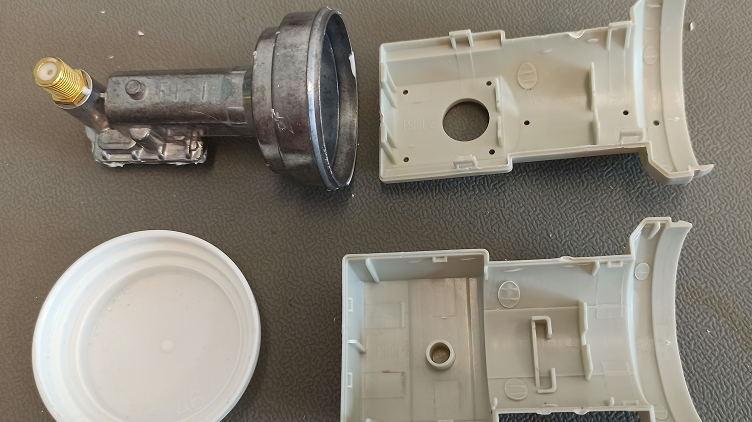A word of advice: If you see an old direct satellite TV dish put out to the curb, grab it before the trash collector does. Like microwave ovens, satellite dishes are an e-waste wonderland, and just throwing them away before taking out the good stuff would be a shame. And with dishes, the good stuff basically amounts to the bit at the end of the arm that contains the feedhorn and low-noise block downconverter (LNB).
But what does one do with such a thing once it’s harvested? Lots of stuff, including modifying it for use with the QO-100 geosynchronous satellite (German link). That’s what [Sebastian Westerhold] and [Celin Matlinski] did with a commodity LNB, although it seems more like something scored on the cheap from one of the usual sources rather than picking through trash. Either way, these LNBs are highly integrated devices that at built specifically for satellite TV use, but with just a little persuasion can be nudged into the K-band to receive the downlink signals from hams using QO-100 as a repeater.
The mods are simple — snipping out the 25 MHz reference crystal on the LNB board and replacing it with a simple LC bandpass filter. This allows the local oscillator on the LNB to be referenced to an external signal generator; when fed with a 25.78 MHz signal, it’s enough to goose the LNB up to 10,490 MHz — right about the downlink frequency. [Sebastian] and [Celin] tested the mods and found that it was easily able to detect the third harmonics of a 3.5-ish GHz signal.
As for testing on actual downlink signals from the satellite, that’ll have to wait. For now, if you’re interested in satellite comms, and you live on the third of the planet covered by QO-100, keep an eye out for those e-waste LNBs and get to work.
















This type of mod is also useful if you wish to have more frequency stability and precision while listening to stuff in the microwave bands using LNB’s, using a precision frequency source in one’s radio shack.
Only question I have is what the common LO crystal frequencies for LNB’s for different satellite bands are.
Well, it is time to dig that out of the scrap iron pile.
You got my interest, living in a low 4g signal area… Tell me more!
Same here!
Simply replace the lnb for an external 4g antenna at its simplest.
Ha! It’s not quite *that* simple as you also need to adjust the arm length / the focal point position for the LNB to receive the optimal 4G signal. I’m absolutely no expert on it but I spent a while looking at different antenna designs and had been tempted by a single yagi, only to then read that it would be better to have two at perpendicular angles to each other, only to *then* come across the math for repurposing a satellite TV antenna for receiving 4G.
I have a 4G modem stick (with an SMA connector for external wand antenna) and figured I could mount that external wand antenna to the appropriate focal point in front of the parabolic dish, with the modem plugged into a router running IPFire. Haven’t actually got round to it yet but that’s the plan.
IIUC it needs to be high up (above other properties and trees), ideally with direct line of sight to the nearest tower.
These concepts are explained in far better detail across various YT videos and websites I came across when searching DDG for a combination of search terms related to 4G parabolic satellite TV antenna conversion but I don’t have those references to hand right now, I’m afraid.
It could also be quite a neat way of ensuring you get decent quality service as, from what I heard RE Brent’s adventures on Jupiter Broadcasting, the network provider actually prioritises your coverage if you have a stronger signal, compared to the coverage of those who have weaker signal.
it makes me nervous that 18 pf ‘s pin almost touch the transistor!
I prefer phaselocking to the middle beacon on QO-100 in GNURadio for spot on frequencies – PE4WJ has a nice blog post on that.
Beware some lnbs can can contain rare toxic material damaging to health. The dust from them could be an issue. Many microwave components may have traces of nasty parts.
Berillium oxide is commonly used.
No risk, no fun…
Or then there’s our family motto: “No beryllium oxide dust, no berylliosis!”
Seriously, though, it looks like a minor health risk for normal folks, but you _do_ want to be careful about not sawing or grinding the stuff.
(https://en.wikipedia.org/wiki/Berylliosis)
That said, I can’t see anything that looks like a beryllium oxide ceramic in this LNB. Am I missing it?
Old TV sat dishes can also be made into stealth slot antennas for 2m or 70 cm. Doesn’t magnify the signal with the dish though, it works the same with a flat piece of metal. About the same performance as a dipole or quarter wave whip, except your HOA allows this because they don’t know it’s a ham antenna and are required by federal law to allow sat tv dishes! Google “2 meter dish slot antenna” for details…
Share here
Sat-forum.net